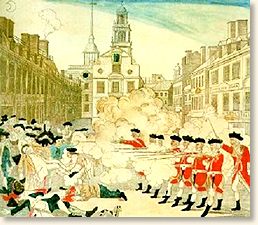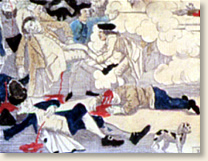|
The Boston Massacre, 1770
The British Perspective
On the evening of March 5, 1770 a group of Boston residents gathered at the local customs house to demonstrate their anger over the various taxes Parliament had recently imposed upon the colonies. Tensions between the Royal soldiers that protected the customs house and the locals had been increasing since the troops had been dispatched to Boston two years earlier.

Paul Revere's Depiction of the Event
|
As the fury of the crowd mounted, a young man hurled an insult at the sentry on duty. The sentry responded by smashing his tormentor's head with his rifle butt. The victim gave a shout and ran from the scene only to return shortly with a group of his friends who joined in the taunting.
Church bells summoned townspeople to the scene. Soon, a crowd of as many as
400 howling, wailing citizens confronted the thirteen-man squad of British
soldiers sent to defend the Customs House. Standing before the mob with fixed-bayonets,
the soldiers were pelted with angry epithets, stones and snowballs. The crowd
advanced to within inches of the besieged soldiers, daring them to fire their
muskets. Suddenly, a member of the squad fired, prompting his colleagues to
fire as well. The crowd fell back in panic revealing three of their number
dead on the ground and another two mortally wounded.
The entire altercation lasted approximately twenty minutes. However, these twenty minutes would have a significant impact on history. Within three days of the event, craftsman Paul Revere produced an engraving depicting the confrontation that was distributed widely throughout the colonies. Its inaccurate portrayal of a well-organized squad of soldiers simultaneously opening fire on a defenseless crowd of citizens helped galvanize colonial opinion against the British and opened the pathway that led to independence six years later.
Captain Thomas Preston was commander of the British squad that evening. He, along with the other members of the squad, was tried for murder in a Boston Court. In the following trial testimony, Captain Peterson describes the events of that evening.
On Monday night about 8 o'clock two soldiers were attacked and beat. But the
party of the townspeople in order to carry matters to the utmost length, broke
into two meeting houses and rang the alarm bells, which I supposed was for
fire as usual, but was soon undeceived.
About 9 some of the guard came to and informed me the town inhabitants were
assembling to attack the troops, and that the bells were ringing as the signal
for that purpose and not for fire, and the beacon intended to be fired to bring
in the distant people of the country. This, as I was captain of the day, occasioned
my repairing immediately to the main guard.
In my way there I saw the people in great commotion, and heard them use the
most cruel and horrid threats against the troops. In a few minutes after I
reached the guard, about 100 people passed it, and went towards the custom
house where the King's money is lodged.
They immediately surrounded the sentry posted there, and with clubs and other
weapons threatened to execute their vengeance on him. I was soon informed by
a townsman their intention was to carry off the soldier from his post and probably
murder him: on which I desired him to return for further intelligence, and
he soon came back and assured me he heard the mob declare they would murder
him. This I feared might be a prelude to their plundering the King's chest.
I immediately sent a non-commissioned officer and 12 men to protect both the
sentry and the King's money, and very soon followed myself to prevent, if possible,
all disorder, fearing lest the officer and soldiers, by the insults and provocations
of the rioters, should be thrown off their guard and commit some rash act.
They soon rushed through the people, and by charging their bayonets in half-circles,
kept them at a little distance. Nay, so far was I from intending the death
of any person that I suffered the troops to go to the spot where the unhappy
affair took place without any loading in their pieces; nor did I ever give
orders for loading them. This remiss conduct in me perhaps merits censure;
yet it is evidence, resulting from the nature of things, which is the best
and surest that can be offered, that my intention was not to act offensively,
but the contrary part, and that not without compulsion.
The mob still increased and were more outrageous,
striking their clubs or bludgeons one against another, and calling out, 'Come
on you rascals, you bloody backs, you lobster scoundrels, fire if you dare,
G-d damn you, fire and be damned, we know you dare not,' and much more
such language was used. At this time I was between the soldiers and the mob,
parleying with, and endeavoring all in my power to persuade them to retire
peaceably, but to no purpose.
They advanced to the points of the bayonets, struck some of them and even
the muzzles of the pieces, and seemed to be endeavoring to close with the soldiers.
On which some well behaved persons asked me if the guns were charged. I replied
yes. They then asked me if I intended to order the men to fire. I answered
no, by no means, observing to them that I was advanced before the muzzles of
the men's pieces, and must fall a sacrifice if they fired; that the soldiers
were upon the half cock and charged bayonets, and my giving the word fire under
those circumstances would prove me to be no officer.

Detail from Paul Revere's
Depiction of the Event
Showing the Victims
|
While I was thus speaking, one of the soldiers having
received a severe blow with a stick, stepped a little on one side and instantly
fired, on which turning to and asking him why he fired without orders, I
was struck with a club on my arm, which for some time deprived me of the
use of it, which blow had it been placed on my head most probably would have
destroyed me. On this
a general attack was made on the men by a great number of heavy clubs and snowballs
being thrown at them, by which all our lives were in imminent danger, some
persons at the same time from behind calling out, ‘damn your bloods-why
don't you fire.’ Instantly three or four of the soldiers fired, one after
another, and directly after three more in the same confusion and hurry. The
mob then ran away, except three unhappy men who instantly expired, ; . . one
more is since dead, three others are dangerously, and four slightly wounded.
The whole of this melancholy affair was transacted in almost 20 minutes.
On my asking the soldiers why they fired without orders, they said they heard
the word fire and supposed it came from me. This might be the case as many
of the mob called out fire, fire, but I assured the men that I gave no such
order; that my words were, don't fire, stop your firing. In short, it was scarcely
possible for the soldiers to know who said fire, or don't fire, or stop your
firing.
On the people's assembling again to take away the
dead bodies, the soldiers supposing them coming to attack them, were making
ready to fire again, which I prevented by striking up their firelocks
with my hand.
Immediately after a townsman came and told me that
4 or 5000 people were assembled in the next street, and had sworn to take
my life with every man's with me. On which I judged it unsafe to remain there
any longer, and therefore sent the party and sentry to the main guard, where
the street is narrow and short, there telling them off into street firings,
divided and planted them at each end of the street to secure their rear,
momently expecting an attack, as there was a constant cry of the inhabitants ‘to arms, to arms, turn
out with your guns;’ and the town drums beating to arms, I ordered my
drums to beat to arms, and being soon after joined by the different companies
of the 29th regiment, I formed them as the guard into street firings.
References:
This eyewitness account appears in: Charles-Edwards, T. and
B. Richardson, They Saw it Happen, An Anthology of Eyewitness’s Accounts
of Events in British History 1689-1897 (1958); Hansen, Harry, The Boston Massacre;
an episode of dissent and violence (1970).
How To Cite This Article:
"The Boston Massacre, The British View, 1770," EyeWitness to History, www.eyewitnesstohistory.com
(2009).
|






